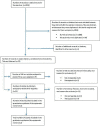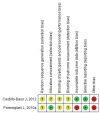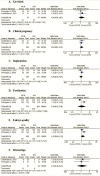Physiological ICSI (PICSI) vs. Conventional ICSI in Couples with Male Factor: A Systematic Review
- PMID: 29672006
- PMCID: PMC5982561
- DOI: 10.5935/1518-0557.20180027
Physiological ICSI (PICSI) vs. Conventional ICSI in Couples with Male Factor: A Systematic Review
Abstract
Objectives: To determine the efficacy of the physiological ICSI technique (PICSI) vs. conventional ICSI in the prognosis of couples, with respect to the following outcome measures: live births, clinical pregnancy, implantation, embryo quality, fertilization and miscarriage rates.
Methods: A systematic review of the literature, extracting raw data and performing data analysis. Patient(s): Couples with the male factor, who were subjected to in-vitro fertilization. Main Outcome Measures: rates of live births, clinical pregnancy, implantation, embryo quality, fertilization and miscarriage.
Results: In the systematic search, we found 2,918 studies and an additional study from other sources; only two studies fulfilled the inclusion criteria for this systematic review. The rates of live births, clinical pregnancy, implantation, embryo quality, fertilization and miscarriage were similar for both groups.
Conclusion: There is no statistically significant difference between PICSI vs. ICSI, for any of the outcomes analyzed in this study. Enough information is still not available to prove the efficacy of the PICSI technique over ICSI in couples with male factor.
Keywords: HA sperm selection; PICSI; hyaluronic acid; male factor; physiological ICSI.
Conflict of interest statement
The authors declare no conflict of interests.
Figures
Similar articles
-
Conventional ICSI vs. physiological selection of spermatozoa for ICSI (picsi) in sibling oocytes.Andrology. 2021 May;9(3):873-877. doi: 10.1111/andr.12982. Epub 2021 Feb 17. Andrology. 2021. PMID: 33523582 Clinical Trial.
-
Is sperm hyaluronic acid binding ability predictive for clinical success of intracytoplasmic sperm injection: PICSI vs. ICSI?Syst Biol Reprod Med. 2014 Dec;60(6):348-54. doi: 10.3109/19396368.2014.948102. Epub 2014 Aug 14. Syst Biol Reprod Med. 2014. PMID: 25119820
-
A prospective randomized study to evaluate the effect of hyaluronic acid sperm selection on the intracytoplasmic sperm injection outcome of patients with unexplained infertility having normal semen parameters.J Assist Reprod Genet. 2013 Nov;30(11):1471-5. doi: 10.1007/s10815-013-0108-9. Epub 2013 Oct 2. J Assist Reprod Genet. 2013. PMID: 24085466 Free PMC article. Clinical Trial.
-
Sperm selection for assisted reproduction by prior hyaluronan binding: the HABSelect RCT.Southampton (UK): NIHR Journals Library; 2019 Feb. Southampton (UK): NIHR Journals Library; 2019 Feb. PMID: 30758931 Free Books & Documents. Review.
-
Sperm chromatin structure assay parameters are not related to fertilization rates, embryo quality, and pregnancy rates in in vitro fertilization and intracytoplasmic sperm injection, but might be related to spontaneous abortion rates.Fertil Steril. 2008 Aug;90(2):352-9. doi: 10.1016/j.fertnstert.2007.06.018. Epub 2007 Sep 27. Fertil Steril. 2008. PMID: 17904130 Review.
Cited by
-
Physiological, hyaluronan-selected intracytoplasmic sperm injection for infertility treatment (HABSelect): a parallel, two-group, randomised trial.Lancet. 2019 Feb 2;393(10170):416-422. doi: 10.1016/S0140-6736(18)32989-1. Lancet. 2019. PMID: 30712901 Free PMC article. Clinical Trial.
-
What Does Intracytoplasmic Sperm Injection Change in Embryonic Development? The Spermatozoon Contribution.J Clin Med. 2023 Jan 14;12(2):671. doi: 10.3390/jcm12020671. J Clin Med. 2023. PMID: 36675600 Free PMC article. Review.
-
Stain-Free Sperm Analysis and Selection for Intracytoplasmic Sperm Injection Complying with WHO Strict Normal Criteria.Biomedicines. 2023 Sep 23;11(10):2614. doi: 10.3390/biomedicines11102614. Biomedicines. 2023. PMID: 37892988 Free PMC article.
-
PICSI vs. MACS for abnormal sperm DNA fragmentation ICSI cases: a prospective randomized trial.J Assist Reprod Genet. 2020 Oct;37(10):2605-2613. doi: 10.1007/s10815-020-01913-4. Epub 2020 Aug 8. J Assist Reprod Genet. 2020. PMID: 32772268 Free PMC article.
-
A Comprehensive Comparison of PICSI and ICSI Techniques Through a Triple-Blinded Trial: Effects on Embryo Quality, Cumulative Pregnancy Rate, and Live Birth Rate.Biomedicines. 2025 May 1;13(5):1104. doi: 10.3390/biomedicines13051104. Biomedicines. 2025. PMID: 40426931 Free PMC article.
References
-
- Azevedo AC, Albuquerque MCRM, Miyasato FC, Fujihara LS, Aranki JT, Albuquerque LET. Comparison Conventional PVP-ICSI vs. HA-PICSI: is there significant improvement in pregnancy rate? Fertil Steril. 2013;100(S530) doi: 10.1016/j.fertnstert.2013.07.286. - DOI
-
- Brassesco-Macazzaga A, Del Río-Bueno F, Cairo-Doncos O, Rovira-Fontanals S, Monqaut A, Brassesco-Macazzaga M. Comparison between hyaluronan (SpermSlow) and polyvinylpyrrolidone media in sperm selection for intracytoplasmic sperm injection. Rev Int Androl. 2009;7:205–209. doi: 10.1016/S1698-031X(09)73387-4. - DOI
-
- Castillo-Baso J, Garcia-Villafaña G, Santos-Haliscak R, Diaz P, Sepulveda-Gonzalez J, Hernandez-Ayup S. Embryo quality and reproductive outcomes of spermatozoa selected by physiologic-ICSI or conventional ICSI in patients with Kruger <4% and >4% normo-morphology. Fertil Steril. 2011;96(S159) doi: 10.1016/j.fertnstert.2011.07.623. - DOI
-
- Castillo-Baso J, García-Villafaña G. Selección Rutinaria de Espermatozoides Utilizando la Tecnica "Physiological ICSI". Subespecialidad: Universidad Autónoma de Baja California; 2012. [Thesis]
Publication types
MeSH terms
Substances
LinkOut - more resources
Full Text Sources
Other Literature Sources




